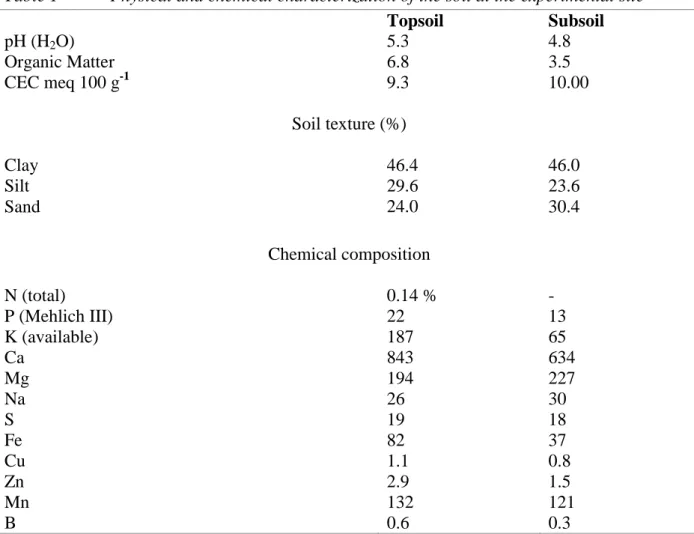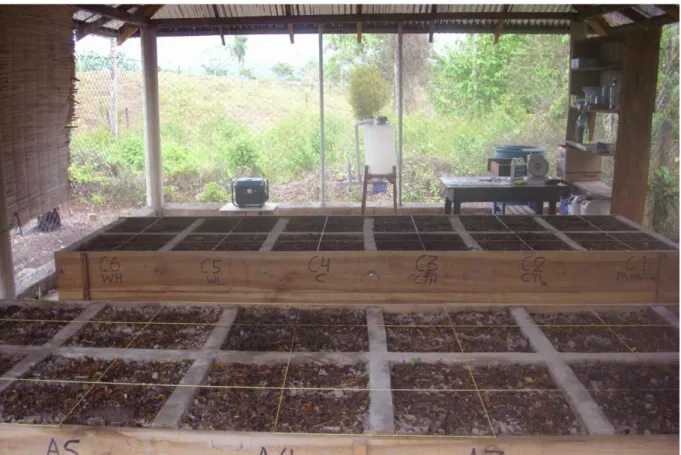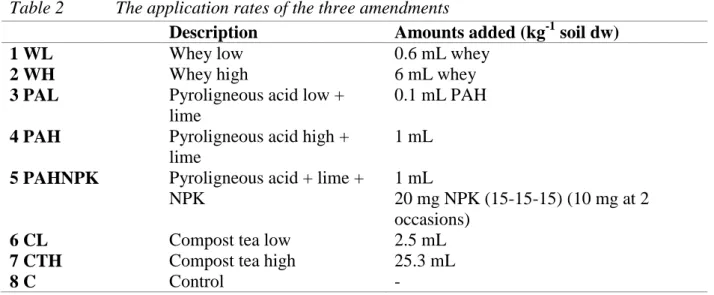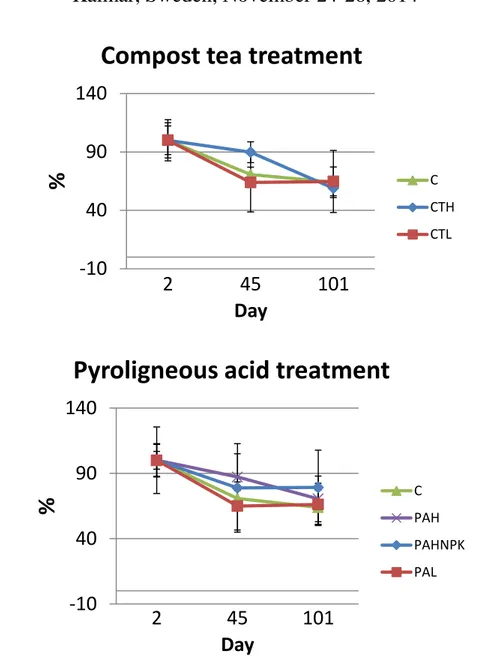ORGANIC BY-PRODUCTS FOR SUSTAINABLE
SOIL REMEDIATION -THE EFFECT OF 3
DIFFERENT AMENDMENTS ON THE
DEGRADATION OF DIESEL FUEL IN A
TROPICAL ULTISOL
Henrik Haller*
Anders Jonsson
Department of Ecotechnology and Sustainable Building Engineering,
Mid Sweden University, Sweden
*Corresponding author: henrik.haller@miun.seABSTRACT
In many tropical developing countries, economic incentives are small for soil remediation to take place. Such locations demand special strategies that are energy-efficient, locally adapted and economic. In situ technologies are appealing where energy and material costs are more limiting than the time factor. One potentially sustainable and economic way to enhance the self-organizing capacity of soil ecosystems is by applications of locally available organic by-products to stimulate the polluted ecosystem´s inherent capacity to heal by utilising the embodied energy of the organic pollutant itself, as an energy source for the necessary biochemical transformations. Tropical climate is favourable for biodegradation but many tropical soils are rich in clay which can inhibit the bioavailability of the pollutant and reduce biodegradation kinetics. A pilot scale experiment was performed in order to assess the capability of three amendments based on by-products; whey, pyroligneous acid and compost
tea, to enhance degradation of diesel in ultisol. Biweekly applications of 6 mL whey kg-1 soil
significantly increased the degradation rate but no positive effect on degradation was found of any of the other amendments.
KEYWORDS
Bioremediation, Self-design, Whey, Pyroligneous acid, Compost teas, Tropical developing countries
1 INTRODUCTION
The handling of petroleum products poses severe environmental problems on a global scale due to spillage. Traditional remediation technologies for contaminated soils include soil excavation, soil vapour extraction, landfarming and natural attenuation (Lynch & Moffat, 2005). Bioremediation is an increasingly used technology that uses living organisms and their enzymes to degrade, remove or immobilize toxic compounds (Vidali, 2001). Soil bioremediation is generally classified as ex situ if the contaminated soil is physically removed from the original site or in situ if the soil is treated in place without excavation. Ex situ bioremediation is typically rather energy-intense and more expensive than in situ bioremediation due to the excavation and transport of polluted soil to the treatment site (Mudhoo & Mohee, 2012).
In low prioritized regions such as tropical developing countries and remote regions, economic incentives are small for soil remediation to take place. Such locations demand special strategies that are energy-efficient, locally adapted and economic. In situ bioremediation technologies are appealing where energy and material costs are more limiting than the time factor (Jonsson & Haller, 2014). One potentially sustainable and economic way to enhance the self-organizing capacity of soil ecosystems is by applications of locally available organic by-products to stimulate the polluted ecosystem´s inherent capacity to heal, using the embodied energy of the organic pollutant itself, as an energy source.
The economy of most developing countries in tropical climate is based on agriculture, livestock, fishing and forestry accounting for 50 % of the employment (Ruane & Sonnino,
2011). Such operations generate a number of by-products of little economic value that
frequently create serious environmental problems when disposed of (Reddy & Yang, 2005). Animal feed has been proposed as an outlet for some of these by-products but due to low levels of protein, high levels of moisture and some anti-nutritional factors i.e. presence of tannins and polyphenols, this practice is limited (Aregheore, 2000; Ulloa, van Weerd, Huisman, & Verreth, 2004) Being inexpensive and easily available sources of carbon, nutrients and bioactive compounds (Ayala-Zavala et al., 2011), many of these by-products can potentially be used as sources of readily available carbon to stimulate microorganisms to degrade toxic compounds (Gadd, 2001).
Temperature is one of the chief factors affecting degradation rates of many pollutants; typically every 10°C increase in temperature doubles the degradation rate (Alexander, 1999; Boopathy, 2000). The high yearly average soil temperatures in tropical regions makes implementation of in-situ soil bioremediation particularly interesting, especially in contaminated areas of little economic value where remediation would not be implemented with more expensive methods. One obstacle is that many tropical soils have a high clay content (Chagas-Spinelli, Kato, de Lima, & Gavazza, 2012) which might decrease the bioavailability of the pollutant and thus obstruct the degradation (Ferguson et al., 2003).
The objective of this study was to examine the capacity of three by-products; whey, pyroligneous acid and compost tea to enhance diesel degradation in tropical clay soil (ultisol).
2 MATERIAL & METHODS 2.1 Experimental station
A research station was built on the experimental farm Casa Montesano (11˚59ˊ70˝ N 84˚53ˊ 06˝ E), 349 m above sea level, in the municipality of Villa Sandino in the province of Chontales, Nicaragua. The region has a humid tropical climate with an average precipitation of 2000 mm per year. The annual average temperature oscillates between 25 and 28˚C. The soil on the experiment site is acid and classified as ultisol according to USDA’s soil taxonomy
system. The average soil bulk density of the top 60 cm used in the experiment was 1.32 g cm-3.
Other characteristics from soil samples of the topsoil (0-30 cm depth) and subsoil (30-60 cm depth) layer taken can be found in table 1.
Table 1 Physical and chemical characterization of the soil at the experimental site
2.2 The pilot scale experiment
The purpose of the pilot scale experimental station is to make possible the simultaneous testing of rather large quantities of contaminated soil. The soil quantity should be large enough to compensate for the inhomogeneity of the soil giving results that are more realistic in comparison to a real in-situ remediation situation. Since there are a number of amendments to
Topsoil Subsoil pH (H2O) 5.3 4.8 Organic Matter 6.8 3.5 CEC meq 100 g-1 9.3 10.00 Soil texture (%) Clay 46.4 46.0 Silt 29.6 23.6 Sand 24.0 30.4 Chemical composition N (total) 0.14 % - P (Mehlich III) 22 13 K (available) 187 65 Ca 843 634 Mg 194 227 Na 26 30 S 19 18 Fe 82 37 Cu 1.1 0.8 Zn 2.9 1.5 Mn 132 121 B 0.6 0.3
be tested and all tests should be carried out in triplicate, the optimum is a trade-off between soil quantity and input resources in terms of time and effort. Hence, 24 compartments were built in concrete with a smooth cement plaster in two sets of twelve compartments each. The compartments were built to hold 150 L of soil each; 50 cm wide×50 cm deep×60 cm high (figure 1).
Figure 1. The interior of the experimental station with its 24 concrete compartments.
Agriculture soil (table 1) from the experimental farm was placed inside each compartment causing as little damage to soil structure as possible. A lid structure of untreated wood was bolted to the compartments to keep the soil from falling out. The compartments were placed under a roof to avoid rainfall and direct sunlight and the whole construction was fenced to keep
animals out. The soil moisture was kept between 0.3- 0.5 g water g-1 soil which resembles
standard conditions during the rainy season.
2.2.1 Diesel contamination
The soil was spiked with commercial diesel fuel to a concentration of 5.00 g diesel kg-1 dw soil.
The diesel was evenly dispersed on top of the soil and left to soak in for 2 days before the first sampling. Before the addition of diesel the debris was removed and subsequently replaced to avoid excessive evaporation.
Each amendment was applied biweekly on day 3, 18, 32, 46, 60, 74, 88 after diesel contamination at rates described in table 2. The compartments that received less liquid than the highest dose (CTH; 5 L per compartment) was compensated for by adding water in order to assure that the 5 L of liquid was added to all boxes.
Table 2 The application rates of the three amendments
Description Amounts added (kg-1 soil dw)
1 WL Whey low 0.6 mL whey
2 WH Whey high 6 mL whey
3 PAL Pyroligneous acid low + lime
0.1 mL PAH
4 PAH Pyroligneous acid high + lime
1 mL
5 PAHNPK Pyroligneous acid + lime + NPK
1 mL
20 mg NPK (15-15-15) (10 mg at 2 occasions)
6 CL Compost tea low 2.5 mL
7 CTH Compost tea high 25.3 mL
8 C Control -
2.2.3 The amendments 2.2.3.1 Compost teas
A cow manure-based vermicompost was used. The cow manure was collected from the neighboring farms and processed during a minimum of 2 weeks by red wrigglers (Eisenia
fetida). The compost tea was made in a commercial vortex airlift bioreactor from keep it simple organics1. The listed ingredients was brewed for 18 hours and applied to the soil without previous filtering immediately after brewing 40 L clear spring water:
2 L vermicompost
0.2 L sugar cane molasses
100 mL soluble seaweed (Ascophyllum Nodosum) extract powder
100 mL granulated humic acid
25 mL fish hydrolysate
2.2.3.2 Whey
The whey was made from local raw milk mixed with the commercial rennet Super cuajo Luna
M., based on enzymes extracted from the fungi Rhizomucor miehei. The dry weight of the whey
was 62.79 g L-1.
2.2.3.3 Pyroligneous acid
1
The PA was made in an artisanal kiln from wood of Erythrina sp. (75%) and Inga sp. (25%) in a slow pyrolysis process that lasted 5 days. The pH of the PA was adjusted to 6 ± 0.2 by
addition of dolomite, 1.66 g L-1. The original pH of the PA was 3.8.
2.2.4. Sampling
Soil samples were taken at day 2, 45,101. At each sampling occasion, samples were taken at 4 spots in each compartment with an iron-manganese steel gouge auger of 13 mm diameter from Eijkelkamp Agriresearch Equipment. A cylindrical soil sample of the entire depth was extracted from the auger with a spatula and placed on a clean paper. All instruments was cleaned with an acetone drenched cloth and subsequently washed with neutral phosphate free detergent and rinsed with water between samplings. Each sample was subsequently divided in two 30 cm sections that were mixed with the corresponding section from the other four specimens from each compartment and stored in 15 mL glass vials. The samples were stored at -20 ˚C in a dark place until analysis.
2.2.5. Chemical Analysis
The soil samples were extracted by pressurized fluid extraction according to EPA standard 3545A. 8 g of soil (wet weight) was mixed with 4 g diatomaceous earth and placed in 22 mL stainless steel extraction cells. Internal standards, 0.5 mL of hexamethylbenzene solution (3.78
g L-1 HMB dissolved in acetone/pentane 50/50) from Sigma Aldrich and 0.5 mL
chlorooctadecane solution (8.00 g L-1 in hexane) from Sigma Aldrich was added to each
extraction cell with a Hamilton® syringe. GC quality hexane and acetone were used as solvents.
The extracts were purified by column chromatography using 1 g silica gel and 2 g sodium sulphate in Pasteur pipettes stuffed with glass wool at the bottom.
Experimental settings for GC-FID were as stated in EPA 8015c, with minor changes. Briefly, injection of 1 µl was done with an MPS2 autosampler (Gerstel). Oven and column were, 6890 GC (Agilent) fitted with an Agilent HP-5 column (30 m × 0.32 mm ID, 0.25 µm film thickness). The following GC program was used: Inlet 200 °C, splitless, constant flow 2.2 mL
min-1 (He), initial oven temperature 45 °C, 3 min → 275 °C (12 °C min-1), hold 12 minutes.
2.2.6. Data analysis
Within an interval between the retention time of C10 (7 minutes) and C28 (23.5 minutes),each
chromatogram was integrated with GC Chemstation (Rev. B.04.03 [16]), according the EPA
method with a fixed baseline starting from C10 until C28. The sum of integrated peaks was
divided in two equidistant groups between C10 and C28 as low boilers and high boilers. For low
boilers, hexamethylbenzene was used as internal standard and 1-chlorooctadecane for the high boilers. Correction with internal standard and dry weight extracted was as follows:
𝑐 =∑𝑛𝑛=1(𝐴𝑛)−𝐴𝑠
𝐴𝑠∗𝑑
Where: c = corrected sum of total area
As = Area of internal standard d = Dry weight after extraction
The degree of degradation was calculated as percentage of the initial values (day 2) of Diesel
Range Organics (C10-C28).
3 RESULTS & DISCUSSION
The results obtained from the experiment are presented in figure 2. The highest degradation rates were found when soil was treated with the high dose of whey (WH, figure 2). This effect of the higher dose of whey is consistent with previous results from laboratory experiments on phenanthrene degradation in diesel contaminated soil (Jonsson & Östberg, 2011) and degradation of diesel fuel in soil from an abandoned petrol station in Sweden (Vilches, Bylund, & Jonsson, 2010). The treatment of the lower dose of whey did not show any positive effect on degradation compared to the control, nor did the other two amendments (PA and CT) in either of the two application rates. PA seems to give a negative effect on degradation especially at the high dose. This suggest that the optimum application rate was exceeded since PA has an inhibitory effect on microorganism at high concentrations (Yoshimura et al., 1995) If PA is to be used to stimulate indigenous soil biota its optimum application rates must be thoroughly assessed under different conditions, considering that the contaminant itself may present an additional inhibitory effect on microorganisms.
-10
40
90
140
2
45
101
%
Day
Whey treatment
WH WL CFigure 2. Effect of the different amendments on the degradation of the total diesel range hydrocarbons.
The overall degradation rate was relatively slow: on average 75% of the diesel remained on day 45 and 66% on day 101. The slow degradation rates may be attributed to oxygen and nutrient deficiency (no additional nutrients were added to balance the C:N:P-ratio after the addition of the carbon rich diesel). Chagas-Spinneli, Kato et al (2012) reported that aeration had a stronger effect on diesel PAH degradation in soil than addition of nutrients and microorganisms by the end of a 129-day experiment in a comparable tropical clay soil (oxisol). Deficient oxygen levels due to restricted diffusion of gases through soil pores in the dense clay soil may have been a contributing factor to the slow degradation rate together with nutrient deficiency.
Other reasons for the slow degradation rates may include reduced bioavailability of the diesel due to sorption of diesel fuel hydrocarbons to organic matter and especially clay particles in the soil matrix (Alexander, 1999; Chagas-Spinelli et al., 2012). Microcosm experiments showed
-10
40
90
140
2
45
101
%
Day
Compost tea treatment
C CTH CTL
-10
40
90
140
2
45
101
%
Day
Pyroligneous acid treatment
C PAH PAHNPK PAL
that degradation of hexadecane (a typical diesel fuel hydrocarbon) was considerably slower in a loamy sand (silt and clay 18.6 %) compared to a sand (silt and clay 3.2 %) after treatment of the diesel fuel contaminated soils with fermented whey (Östberg, Jonsson, & Lundström, 2007).
The problems and limitations encountered during this initial trial experiment will be addressed in forthcoming pilot scale experiments. The constraints attributed to the clay content in soil will be subject to further investigations. Also, the effect of addition of macro nutrients (nitrogen and phosphorous) will be assessed.
4. CONCLUSION
Treatment of diesel contaminated ultisol with 6 mL whey kg-1 dw in a pilot-scale
experiment considerably increased the diesel degradation rate compared to the control.
No effects on diesel degradation rates were observed after treatment with compost tea
or pyroligneous acid.
High clay content of many tropical soils may be a limiting factor to diesel degradation.
Further experiments are needed to evaluate the usefulness of organic by-products for
soil remediation purposes.
ACKNOWLEDGEMENT
We gratefully acknowledge the financial support of the European Regional Development Fund. Assistance with the GC/FID analysis provided by Joel Ljunggren and Erik Hedenström from Department of Chemical Engineering, mid Sweden University was greatly appreciated.
REFERENCES
Alexander, M. (1999). Biodegradation and Bioremediation (2 ed.). San Diego: Academic Press.
Aregheore, E. M. (2000). Chemical composition and nutritive value of some tropical
by-product feedstuffs for small ruminants — in vivo and in vitro digestibility. Animal Feed
Science and Technology, 85(1–2), 99-109. doi: http://dx.doi.org/10.1016/S0377-8401(00)00123-1
Ayala-Zavala, J. F., Vega-Vega, V., Rosas-Dominguez, C., Palafox-Carlos, H., Villa-Rodriguez, J. A., Wasim Siddiqui, M., . . . González-Aguilar, G. A. (2011). Agro-industrial potential of exotic fruit byproducts as source of food additives. Food
Research International, 44(7), 1866-1874.
Boopathy, R. (2000). Factors limiting bioremediation technologies. Bioresource Technology,
74(1), 63-67. doi: http://dx.doi.org/10.1016/S0960-8524(99)00144-3
Chagas-Spinelli, A. C. O., Kato, M. T., de Lima, E. S., & Gavazza, S. (2012). Bioremediation of a tropical clay soil contaminated with diesel oil. Journal of Environmental
Management, 113(0), 510-516. doi: http://dx.doi.org/10.1016/j.jenvman.2012.05.027 Ferguson, S. H., Franzmann, P. D., Snape, I., Revill, A. T., Trefry, M. G., & Zappia, L. R.
(2003). Effects of temperature on mineralisation of petroleum in contaminated Antarctic terrestrial sediments. Chemosphere, 52(6), 975-987.
Jonsson, A. P., & Haller, H. (2014). Sustainability Aspects of In-Situ Bioremediation of Polluted Soil in Developing Countries and Remote Regions. In M. C. Hernandez Soriano (Ed.), Environmental Risk Assessment of Soil Contamination: InTech. Jonsson, A. P., & Östberg, T. L. (2011). The effects of carbon sources and micronutrients in
whey and fermented whey on the kinetics of phenanthrene biodegradation in diesel contaminated soil. Journal of Hazardous Materials, 192(3), 1171-1177. doi: 10.1016/j.jhazmat.2011.06.024
Lynch, J. M., & Moffat, A. J. (2005). Bioremediation - prospects for the future application of innovative applied biological research. Ann. Appl. Biol., 146(2), 217-221.
Mudhoo, A., & Mohee, R. (2012). Elements of Sustainability and Bioremediation
Bioremediation and Sustainability (pp. 1-41): John Wiley & Sons, Inc.
Reddy, N., & Yang, Y. (2005). Biofibers from agricultural byproducts for industrial applications. Trends in Biotechnology, 23(1), 22-27.
Ruane, J., & Sonnino, A. (2011). Agriculture biotechnologies in developing countries and their possible contribution to food security. Journal of Biotechnology, 156(4), 356-363. Ulloa, J. B., van Weerd, J. H., Huisman, E. A., & Verreth, J. A. J. (2004). Tropical agricultural
residues and their potential uses in fish feeds: the Costa Rican situation. Waste
Management, 24(1), 87-97. doi: http://dx.doi.org/10.1016/j.wasman.2003.09.003 Vidali, M. (2001). Bioremediation, An Overview. Pure and Applied Chemistry, 73(7),
1163-1172.
Vilches, A. P., Bylund, D., & Jonsson, A. P. (2010, November 22-24. 2010). Enhanced Natural
Biodegradation of Diesel Fuel Contaminants in Soil by Addition of Whey and Nutrients.
Paper presented at the Proceedings of Linnaeus ECO-TECH ´10, Kalmar, Sweden. Yoshimura, H., Washio, H., Yoshida, S., Seino, T., Otaka, M., Matsubara, K., & Matsubara, M.
(1995). Promoting effect of wood vinegar compounds on fruit-body formation of Pleurotus ostreatus. Mycoscience, 36(2), 173-177.
Östberg, T. L., Jonsson, A. P., & Lundström, U. S. (2007). Enhanced degradation of
n-hexadecane in diesel fuel contaminated soil by the addition of fermented whey. Soil and



